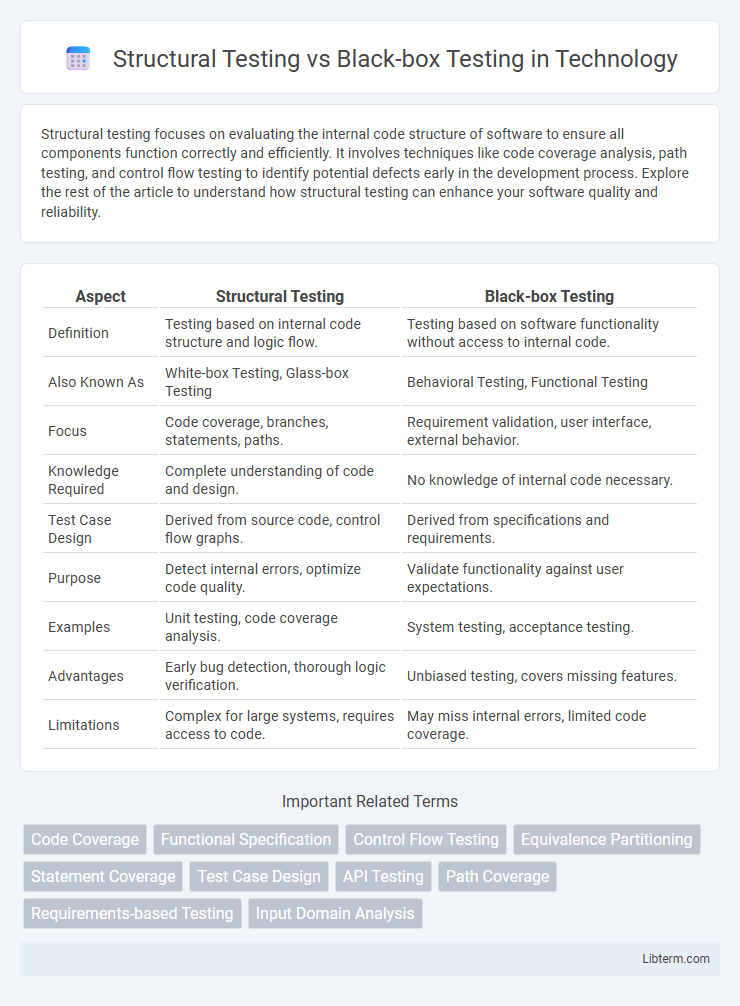Structural testing focuses on evaluating the internal code structure of software to ensure all components function correctly and efficiently. It involves techniques like code coverage analysis, path testing, and control flow testing to identify potential defects early in the development process. Explore the rest of the article to understand how structural testing can enhance your software quality and reliability.
Table of Comparison
| Aspect | Structural Testing | Black-box Testing |
|---|---|---|
| Definition | Testing based on internal code structure and logic flow. | Testing based on software functionality without access to internal code. |
| Also Known As | White-box Testing, Glass-box Testing | Behavioral Testing, Functional Testing |
| Focus | Code coverage, branches, statements, paths. | Requirement validation, user interface, external behavior. |
| Knowledge Required | Complete understanding of code and design. | No knowledge of internal code necessary. |
| Test Case Design | Derived from source code, control flow graphs. | Derived from specifications and requirements. |
| Purpose | Detect internal errors, optimize code quality. | Validate functionality against user expectations. |
| Examples | Unit testing, code coverage analysis. | System testing, acceptance testing. |
| Advantages | Early bug detection, thorough logic verification. | Unbiased testing, covers missing features. |
| Limitations | Complex for large systems, requires access to code. | May miss internal errors, limited code coverage. |
Introduction to Structural Testing
Structural testing, also known as white-box testing, involves evaluating the internal logic, code structure, and implementation of software. This method systematically examines control flow, data flow, and path coverage to ensure thorough validation of all code components. Structural testing enables early defect detection by directly assessing the program's source code, improving software reliability and robustness.
Understanding Black-box Testing
Black-box testing evaluates software functionality without knowledge of the internal code structure, focusing solely on input-output behavior to ensure requirements are met. It identifies discrepancies by examining how the system responds to valid and invalid inputs, enhancing user experience and detecting functional errors. This approach contrasts with structural testing, which analyzes the internal workings and code pathways to optimize coverage and correctness.
Key Differences Between Structural and Black-box Testing
Structural testing examines the internal code structure, logic, and implementation details to design test cases, while black-box testing evaluates software functionality without knowledge of internal workings. Structural testing requires access to source code and is often used for unit and integration testing, whereas black-box testing focuses on inputs and expected outputs, commonly applied in system and acceptance testing. The key difference lies in visibility: structural testing is code-driven, and black-box testing is behavior-driven.
Advantages of Structural Testing
Structural testing offers precise insights into code coverage, enabling the identification of hidden errors and ensuring that all internal paths are exercised. It facilitates early defect detection by thoroughly verifying the program's logic and control flow, reducing the risk of failure in later stages. This method improves code quality and maintainability by promoting comprehensive test suites tailored to the software's internal structure.
Benefits of Black-box Testing
Black-box testing offers the advantage of validating software functionality without requiring knowledge of internal code structure, making it ideal for user-centric testing scenarios. It effectively identifies discrepancies in input-output behaviors, ensuring that the application meets specified requirements and improves overall user experience. This testing approach facilitates early detection of issues in integration and system levels, enhancing software reliability and reducing time-to-market.
Use Cases for Structural Testing
Structural testing, also known as white-box testing, is predominantly used in scenarios requiring detailed code analysis, such as unit testing and integration testing, where the internal logic and structure must be validated. It is essential for identifying hidden software errors, verifying code paths, and ensuring all statements and branches are adequately executed, especially in safety-critical systems like aerospace and medical devices. Structural testing is also vital in optimizing complex algorithms, improving code maintainability, and early defect detection during the development lifecycle.
When to Choose Black-box Testing
Black-box testing is ideal when the tester lacks knowledge of the internal code structure or when validating software functionality against specified requirements. It is best suited for acceptance, system, and regression testing phases where the emphasis is on output correctness rather than internal logic. This approach efficiently identifies discrepancies in user interface, input-output behavior, and overall system operations without delving into implementation details.
Challenges in Structural and Black-box Testing
Structural testing faces challenges such as requiring detailed knowledge of the internal code, making it time-consuming and complex for large systems. Black-box testing struggles with incomplete coverage since testers lack insight into the internal structure, leading to potential undiscovered defects. Both methods face difficulties in balancing thoroughness with resource constraints, impacting testing efficiency and effectiveness.
Best Practices for Combining Both Testing Methods
Combining structural testing and black-box testing enhances software quality by leveraging code coverage metrics alongside requirement-based validation to detect defects comprehensively. Best practices include aligning test cases to cover both internal code logic through unit and integration testing, and external functionality via system and acceptance testing, ensuring thorough evaluation of software behavior and implementation. Integrating automated tools for structural analysis with exploratory black-box techniques optimizes test effectiveness and improves defect detection rates across various software layers.
Conclusion: Selecting the Right Testing Approach
Selecting the right testing approach depends on the project requirements, with structural testing offering detailed code coverage insights by examining internal logic, while black-box testing focuses on validating external functionality without code knowledge. Structural testing is ideal for identifying hidden errors and optimizing code quality, whereas black-box testing excels in user experience and requirement verification. Combining both methods often yields comprehensive software quality assurance and risk mitigation.
Structural Testing Infographic

 libterm.com
libterm.com